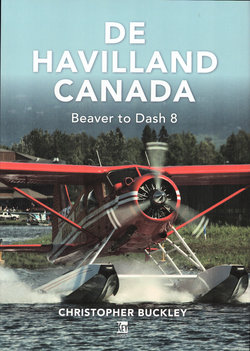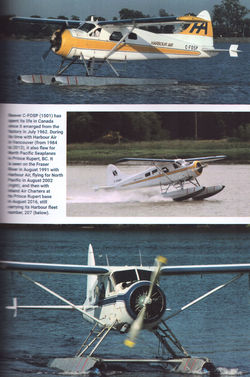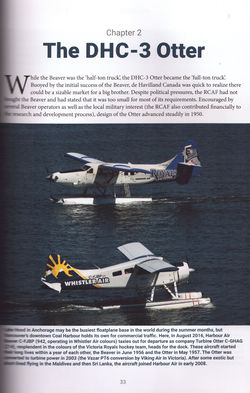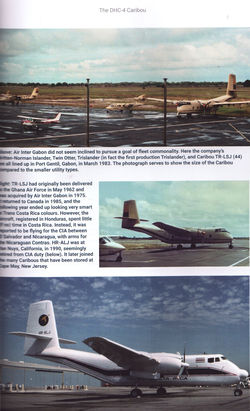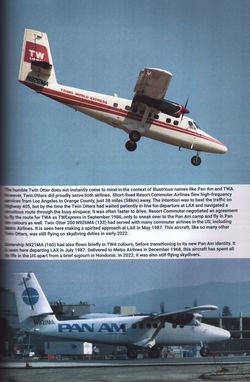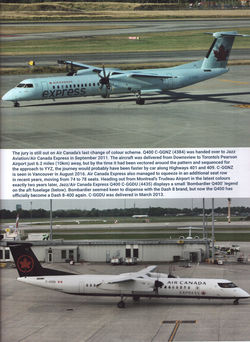DE HAVILLAND CANADA
BEAVER TO THE DASH 8 BUSHPLANES FLOATPLANES STOL TRANSPORTS MILITARY TRANSPORT
CIVILIAN AIRLINERS RCAF U.S. ARMY
KEY PUBLISHING HARDBOUND BOOK with DUSTJACKET HBDJ in ENGLISH by CHRISTOPHER BUCKLEY
---------------------------------------
Additional Information from Internet Encyclopedia
De Havilland Aircraft of Canada Limited (DHC) is a
Canadian aircraft manufacturer that has produced numerous aircraft models since
its inception including the popular Dash 8. The company's primary facilities
were located in the Downsview area of Toronto, Ontario for many years; in 2022,
it was announced that it would relocate primary manufacturing to De Havilland
Field, under development near Calgary, Alberta.[4] The aircraft types currently
in production or planned for production include the DHC-6 Twin Otter, DHC-8
Dash 8, and DHC-515 Firefighter.
The aircraft company was created in 1928 by the British
de Havilland Aircraft Company to build Moth aircraft for the training of
Canadian airmen, and subsequently after the Second World War, designed and
produced indigenous designs.
In the 1980s, the government of Canada under Prime
Minister Brian Mulroney privatized DHC and in 1986 sold the aircraft company to
then Seattle-based Boeing.
DHC was eventually acquired by Montreal-based Bombardier
Aerospace in 1992[8] after cumulative losses of US$ 636 million over five years
under the helm of Boeing.
In 2006, Viking Air of Victoria, British Columbia,
purchased the type certificates for all the original out-of-production de
Havilland designs (DHC-1 to DHC-7).
In November 2018, Viking Air's holding company, Longview
Aviation Capital, announced the acquisition of the Q400 program, along with the
rights to the de Havilland name and trademark. The deal, which closed on 3 June
2019 following regulatory approval, brought the entire de Havilland product
line under the same banner for the first time in decades, under a new holding
company named De Havilland Aircraft of Canada Limited.
In the summer of 2021, De Havilland stopped production at
its Downsview site and officially closed it in the summer of 2022 at the end of
its lease. In September 2022, De Havilland announced its plans to construct a
new manufacturing facility, De Havilland Field, in Wheatland County, Alberta.
The new facility is intended to merge its two manufacturing facilities and
produce the Twin Otter and Dash 8 planes, as well as the new DHC-515
firefighting aircraft. First production at the new site is planned to begin in
2025.
Establishment
Founded in 1928 as a subsidiary of de Havilland Aircraft
(UK), de Havilland Canada was first located at De Lesseps Field in Toronto,
before moving to Downsview Airport in 1929.
The original home of De Havilland Canada was the Canadian
Air and Space Museum located in what is now Downsview Park.
Pre-Second World War
Flown for the first time on 26 October 1931, the DH.82
Tiger Moth was derived from the DH.60 Moth. The DH 82 was powered by a 120-hp
Gipsy II engine, but the 1939 DH.82a received the 145-hp Gipsy Major. More than
1,000 Tiger Moths were delivered before the Second World War, and subsequently
4,005 were built in the UK and shipped all over the world; 1,747 were built in
Canada (the majority being the DH.82c model with enclosed cockpits, brakes,
tail wheels, etc.). The follow-up DH.83 Fox Moth was designed in England in
1932 as a light, economical transport and was built using as many Tiger Moth
components as possible.
Second World War
The de Havilland Tiger Moth was a basic trainer of the
British Commonwealth Air Training Plan during the Second World War, whereby air
crews from all over the British Commonwealth trained in Canada. DHC was the
Canadian unit of the parent British de Havilland and during World War II was
made into a crown corporation of the government of Canada.
Production of the Mosquito, nicknamed the
"Mossie", was the company's greatest contribution to the war effort.
It was one of the few front-line aircraft of the era constructed almost
entirely of wood and was nicknamed the "Wooden Wonder". The Mosquito
was designed to use speed instead of defensive armament to evade attack, and as
a result, it was one of the fastest aircraft in the war, reaching 425 mph at
30,000 ft. The original design was intended as a light bomber, but soon proved
itself in high-level photography and every phase of intruder operations.
Of the more than 7,000 Mosquitoes produced overall by de
Havilland, de Havilland Canada produced 1,134. Some 500 were delivered to the
UK by the end of the war, although several were lost en route across the
Atlantic.
Post-war era
After the war, de Havilland Canada began to build its own
designs uniquely suited to the harsh Canadian operating environment. The
company also continued production of several British de Havilland aircraft and
later produced a licence-built version of the American-designed Grumman S2F
Tracker. In 1962, the Avro Canada aircraft production facility was transferred
to de Havilland Canada by their then-merged parent company, UK-based Hawker
Siddeley.
DHC-2 Beaver
Developed in 1947 for bush flying, the DHC-2 Beaver was
designed with input from Canada's bush pilots, who desired a rugged and highly
versatile "aerial truck" that would reliably deliver short takeoff
and landing (STOL) performance from unimproved airstrips with a half-ton load.
An all-metal, high wing monoplane, the Beaver could be equipped with wheels,
skis, or floats, and was originally powered by a single Pratt & Whitney
R-985 Wasp Junior piston engine. The Beaver was soon adopted by the US Air
Force (USAF) and US Army as a liaison aircraft, remaining in service well into
the 1970s, and was also used by the militaries of numerous other nations,
including Britain, Chile, and Colombia. With almost 1,700 built in a production
run lasting two decades, civil Beavers continue plying their trade in many
countries around the world. A turboprop conversion, the Turbo Beaver first flew
in December 1963, featuring a Pratt & Whitney PT6A engine. The Turbo Beaver
offered improved operating weights and STOL performance, along with a longer
cabin, allowing maximum accommodation for 11 including the pilot. DHC offered
turboprop conversion kits to upgrade piston-powered Beavers, and similar
conversions have been performed by aftermarket companies.
DHC-3 Otter
A follow-on design to the Beaver�originally conceived in
1951 as the King Beaver�the DHC-3 Otter was designed for the same basic roles
and is similar in layout, but is a substantially larger and heavier aircraft, a
veritable "one-ton truck" that can seat up to eleven. The Otter was
originally produced with a 450-kW (600-hp) Pratt & Whitney R-1340 Wasp
radial engine, and like the Beaver, the Otter can be fitted with skis and
floats; the Otter amphibian features a four-unit retractable undercarriage,
with the wheels retracting into the floats. The type's first flight was
undertaken on 12 December 1951 and Canadian certification was awarded in
November 1952. The US Army became the largest user of the Otter, and other
military users included Australia, Canada, and India. Some Otters have been
converted to turboprop power by Cox Air Services using a Pratt & Whitney
Canada PT6A turboprop, yielding a lower empty weight and a higher maximum
speed, and a number of other aftermarket PT6A conversions have been offered. The
Otter found a significant niche as a STOL bush aircraft and many remain in
service.
DHC-4 Caribou
The DHC-4 Caribou was a rugged STOL design like the
Beaver and Otter, but it had two engines and was conceived primarily as a military
transport, designed in response to a US Army requirement for a tactical
airlifter to supply the battlefront with troops and supplies and evacuate
casualties on the return journey. The DHC-4 first flew on 30 July 1958. The US
Army ordered five for evaluation and went on to become the largest Caribou
operator, taking delivery of 159, initially as the AC-1 and later as the CV-2.
These aircraft were transferred to the USAF in 1967 and redesignated as the
C-7, seeing extensive service during the Vietnam War, where some were captured
by North Vietnamese forces and operated until the late 1970s. Other notable
military operators included Canada, Australia, Malaysia, India, and Spain. The
type's ruggedness and STOL capabilities also appealed to some commercial users
and US certification was awarded on 23 December 1960. Other Caribou entered
commercial service after being retired by the military, and some civil Caribou
have been fitted with turboprop engines.
DHC-5 Buffalo
Known originally as the Caribou II, the DHC-5 Buffalo was
basically an enlarged DHC-4 with turboprop engines and a T-tail, developed to
meet a US Army requirement for a STOL tactical airlifter with greater
load-carrying ability than the DHC-4. The Buffalo made its maiden flight on 9
April 1964, but the US Army soon transferred heavy fixed-wing aircraft
operations to the USAF, which had little interest in the Buffalo; only four
evaluation aircraft were delivered to the US military, two of which were later
transferred to NASA for research. The improved DHC-5A transport was acquired by
Canadian Armed Forces (as the CC-115), the Brazilian Air Force and the Peruvian
Air Force, and the production line was then shut down, but it was reopened
after the enhanced DHC-5D was introduced in response to interest by other
military users. In the early 1980s, de Havilland Canada attempted to market the
Buffalo for civil use as the "Transporter", but the demonstration
aircraft crashed at the 1984 Farnborough Airshow and the project was abandoned.
DHC-6 Twin Otter
One of Canada's most successful commercial aircraft
designs with more than 990 built, the Twin Otter remains popular for its rugged
construction and STOL capabilities. Development dates back to January 1964,
when DHC commenced work on a twin turboprop variant of the DHC-3 Otter as a
STOL commuter airliner and utility transport. The wings were lengthened, the
rear fuselage, tail, and nose were redesigned, and seating capacity was
increased to 18. Design features included double-slotted trailing-edge flaps and
flaperons (ailerons that act in unison with the flaps) to boost STOL
performance. The type's first flight on 20 May 1965. After receiving
certification in mid-1966, the first Twin Otter variant, the Series 100,
entered service with the Ontario Department of Lands and Forests. The Series
200, introduced in April 1968, had an extended nose and reconfigured rear cabin
storage compartment, greatly increasing cargo space. The Series 300, introduced
in 1969, had more powerful engines, allowing a 450-kg (1,000-lb) increase in
takeoff weight and a 20-seat interior. All models can be fitted with skis or
floats. DHC production ceased in late 1988, but in 2010, Viking Air restarted
Twin Otter production with the introduction of the Series 400.[13] Production
was suspended during the COVID-19 pandemic; in July 2022, the company announced
that it was reviewing the programme and supply chain, with a decision on when
to resume production expected "in the near future".
DHC-7 Dash 7
The four-engined DHC-7, popularly known as the Dash 7,
was designed as a STOL 50-seat regional airliner capable of operating from
strips as short as 915 metres (3,000 ft) in length. It was meant to serve small
city airports, where noise abatement requirements were particularly strict, and
featured four slow-turning propellers to cut noise. To enhance its STOL
performance, the Dash 7 employs many aerodynamic devices, such as
double-slotted wing flaps that span about 75% of the trailing edge of the wing
and four spoilers per wing; on landing, the flaps partially retract and the
spoilers fully deploy to maximize braking. Financial backing from the Canadian
government allowed the launch of the DHC-7 program in the early 1970s,
resulting in the maiden flight on 27 March 1975. The type was certificated on 2
May 1977 and entered service with Rocky Mountain Airways on 3 February 1978.
Offered in passenger, freighter, and combi aircraft configurations, production
of the Dash 7 ended in 1988 following Boeing's takeover of DHC.
DHC-8 Dash 8
De Havilland Canada began development of the Dash 8 in
the late 1970s in response to high anticipated demand for regional airliners.
Like the Dash 7, the Dash 8 features a high-mounted wing and T-tail, an
advanced flight control system, and large full-length trailing-edge flaps, but
power is supplied by two Pratt & Whitney Canada PW120 turboprops,
emphasizing operating economy over STOL performance�a major departure for DHC
that proved very successful. The first flight took place on 20 June 1983, Canadian
certification was awarded on 28 September 1984, and the first customer delivery
was to NorOntair on 23 October 1984. When the Dash 8 was introduced, many older
regional airliners were becoming obsolescent and expensive to operate but few
modern aircraft were immediately available to replace them, leading to
substantial Dash 8 sales; to date, over 1,000 have been delivered. The Dash 8
has been offered in several lengths and operating weights, but in 2008,
Bombardier announced the discontinuation of the shorter and less powerful
variants, leaving the Q400 as the only Dash 8 still in production.
As of February 2023, De Havilland Canada has four DHC-8s
registered with Transport Canada and operate as ICAO airline designator DHC,
and telephony DEHAVILLAND.



